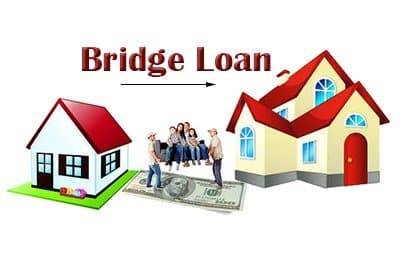A bridge loan is used when someone wants to sell an old property to buy a new property but cannot sell the old one before the required time. He or she uses this loan to purchase the new property and pays it back when he or she sells the old property. But there are conditions to getting a bridge loan, and in this article, we will help you understand the definition of a bridge loan for a mortgage, who offers bridge loans, bridge loan requirements, and finally, bridge loan rates.
Bridge Loans
This is short-term financing issued to anyone over a specific period as a loan to acquire a specified property (home) or solve a taxing issue. It is normally used to solve an immediate problem. However, this group or person is expected to provide collateral in the form of a property or business and is required to pay back the loan with interest over a specified period. Meanwhile, it is used to bridge the gap between short-term cash needs and long-term debt obligations. Normally, these loans are for a duration of 12 months or less, and there are necessary requirements to qualify for a bridge loan.
The loan might be paid back in predetermined monthly installments. Another alternative demands a one-time payment at the conclusion of the loan period or when the property is sold, with interest sometimes collected during this time. Alternatively, the loan could be set up with monthly interest-only payments and a balloon payment at the end of the term or when the house is sold. Repayments are frequently not due for several months after the loan is closed.
Who Offers Bridge Loans?
A bridge loan can be received from credit unions or financial institutions like central banks, retail and commercial banks, internet banks, savings and loan associations, investment banks, investment companies, brokerage firms, insurance companies, and mortgage companies. However, it is mostly offered by mortgage companies.

The Pros and Cons of Bridge Loans
#1. Pros
- It is fast and readily available to anyone who qualifies for a loan.
- Its application process is simpler than a traditional loan.
- A bridge loan only takes 20% of the downpayment to qualify for one.
- It is good to solve immediate problems, such as lacking funds to buy a house at an auction.
#2. Cons
- It takes a lot of money from your pocket after helping you solve a problem.
- Bridge loan rates are high and their duration is short-term. Therefore, it can be stressful if it takes longer to sell your house than expected.
- Many financial organizations will only provide you with a bridge loan if you also get a new mortgage from them.
- A bridge loan comes with many requirements for the application that can limit certain people from getting loans.
- There are situations where a borrower’s old property will not sell within the term of the bridge loan.
Bridge Loans for Mortgage
A bridge loan for a mortgage is a loan received from banks, mortgage companies, or similar institutions to acquire or develop a house, land, or any property associated with real estate. However, it is issued to a borrower for a short time. Meanwhile, the lender provides requirements that must be met by the borrower, like a 20% downpayment and collateral, and also that the borrower is to pay back the loaned money. plus interest at the given time. The bridge loan for a mortgage has a higher interest rate than the conventional mortgage loan.
Therefore, people mostly try to roll their mortgages into one. This option allows you to take out a large loan for up to 80% of the value of your house. You pay off your first mortgage and put the rest toward your future home’s down payment. Bridge loans may be utilized for a number of mortgage purposes, including
- Acquiring a new property with a quick closing schedule,
- House renovation
- Selling a house or land in a shorter amount of time.
- It is good for solving short-term problems affecting a piece of land or house, for example, land flooding.
How Much Can I Borrow for Bridge a loan?
A bridge loan is mainly used in real estate and in a situation where you want to buy a house that costs as much as $450,000. The maximum amount you can borrow is 80% of the total value of the new house and your current home. For instance, if your current home is worth $500,000, your maximum loan will be $760,000, which is (450,000 + $500,000)* (80/100).
Bridge Loan Requirements
Applying for a bridge loan is much easier than for a traditional loan. There are some necessary qualifications to determine a borrower’s eligibility.
Firstly, necessities like low debt-to-income ratios, LTV, credit history, and credit scores (FICO) matter because they’re necessary for the process.
LTV stands for loan to value. It is a ratio of the proportional difference between the loan amount and the current market value of your home, and it is used to access risk before authorizing a mortgage. Meanwhile, the (FICO) credit score stands for Fair Isaac Corporation. It is a figure or number used to estimate your chances of repaying a loan on time. Lenders use credit ratings to make judgments like whether or not to lend you money.
Secondly, because you want to borrow up to 80% of the value of the house, you’ll need a lot of equity in your present home. However, your equity is the difference between your present home value and the amount you owe in debt.
Thirdly, your lender will also look at your debt-to-income ratio, which compares how much money you make to how much money you have to spend each month, taking into account existing loans like your current mortgage. It demonstrates to lenders that you are not taking on more debt than you can manage. Given the expense of two mortgages, it can be difficult to qualify for a bridge loan without a low debt-to-income ratio.
Finally, these loans are usually only available to those with excellent credit histories and scores. While minimum credit scores may vary by lender, the higher your credit score, the cheaper your interest rate will be.
As for a bridge loan for business
The lender will also require the documents below.
- Credit report
- Tax returns
- business plan
- Company profile
- Renovation costs and schedule
- Detail your exit strategy (refinancing, selling, or other funding sources).
Bridge Loan Rates
Bridge loans have high-interest rates, which range between 8.5% and 10.5%. Interest rates for bridge loans vary depending on your creditworthiness and the size of the loan. Meanwhile, they often range from 3.25% to 8.5% or 10.5%.
For this reason, it is more expensive than traditional, long-term financing options. However, the bridge loan application and underwriting process are generally faster than traditional loans.
Eventually, bridge loans require borrowers to pay closing costs and also legal administrative fees.
In addition to paying interest on the bridge loan, borrowers must pay closing costs and additional legal and administrative fees. Meanwhile, the closing costs and fees typically vary from 1.5 percent to 3 percent of the total loan. These closing fees may include a registration fee, evaluation fee, administration fee, agreement fee, notary fee, and loan origination fee. The bridge loan can be repaid with cash obtained after selling an old property or with cash from an expected income as agreed on at the time of collection.
When to repay a bridge loan
Repayment varies with institutions and also with requirements and conditions, which are considered before giving out a bridge loan. The general bridge loan ending date is usually within a year or 12 months, as the case may be. However, some loan companies might require monthly payments of interest until the final month of full payment, and it is all based on the initial agreement after checking out your credit score.
When to use a bridge loan
- Bridge loans are normally used when you don’t have funds to buy a new house before selling an old one or when you can’t afford a down payment for a new house without selling the old one.
- You can use this loan in a case of relocation and you probably do not have enough funds to purchase a new house but have significant equity in your property and have no outstanding debt at all.
- Companies can use a bridge loan as an option to secure an opportunity, finance their business, and do renovations until they qualify for a traditional loan.
- You can use it when a house seller rejects your contingent purchase offer.
- On many occasions, it provides you with funds in a situation whereby you lack funds to buy a new home at auction, provided you have enough equity in your home.
What Are the Types of Bridge Loan?
- Open bridge loan. These are flexible loans. It is suitable for individuals who are uncertain when their finances will be available. This type of loan is however expensive, due to the risk carried to the creditor.
- Close bridge loan. This type of bridge loan carries a lower risk hence, cheaper. It is offered in situations where a borrower has a clear date of repayment and credible repayment plan.
What Is a Loan to Value (LTV) ?
Loan to Value is a ratio used to calculate the difference between how much you want to borrow and the value of the assets you are borrowing against.
What Is First and Second Charge Bridging Loan ?
- First charge loans are loans where it is the first or only loan secured against your property.
- Second charge loan are when you take out another loan on a property you already have a loan on.
Advantages of a Bridge Loan
- Quick and easy process
- Lending criteria is flexible
- Large amounts can be borrowed
- Poor credit score is accepted
- Quick lending decision
What Are the Consequences of Bridging a Loan?
- A higher interest rate
- The closing fee and other fees involved can drive up your total costs
- A short term finance, hence expensive.
What Are Alternatives to Bridging Loans?
- Fast house buying companies.
- Approaching family for loan
- Commercial mortgages
- Secured loans such as second charge mortgages
- Refurbishment loans
- Property Development Finance
- Mortgages
- Private investor
The Difference Between Bridge Loans and Mortgages are ?
- Bridge loans are for a very short period of time. while mortgages are for a long period of time.
- Bridge loans have a quick processing time unlike mortgages, which take time.
- The interest rate charged on mortgages is relatively cheaper than that of bridge loans.
- Bridge loans offers flexibility when compared to mortgages.
Conclusion
A bridge loan can come in handy in certain circumstances, if you find yourself in urgent need of buying a new home before an old one has sold. However, you’ll also add to your overall debt load and may end up paying off multiple loans simultaneously if your current home doesn’t promptly sell. In case you have second thoughts about the success of your endeavor, you should seek the help of experts in the field who can surely help you to make the best decisions for you in the long run!
Bridge Loans FAQs
Bridge Loan Mortgage
A bridge loan for a mortgage is a loan received from banks, mortgage companies, or similar institutions to acquire or develop a house, land, or any property associated with real estate. However, it is issued to a borrower for a short time.
What is the interest rate for a bridge loan?
Bridge loans have high-interest rates, which range between 8.5% and 10.5%. Interest rates for bridge loans vary depending on your creditworthiness and the size of the loan. It often ranges from 3.25% to 8.5% or 10.5%.
What is a bridge loan example?
A bridge loan is mainly used in real estate and in a situation where you want to buy a house that costs as much as $450,000. The maximum amount you can borrow as a bridge loan is 80% of the total value of both the new house and your current home. For instance, if your current home is worth $500,000, your maximum loan will be $760,000, which is (450,000 + $500,000)* (80/100).
RELATED ARTICLES
HARD MONEY LENDERS: Best Hard Money Lenders For The First Time Investors (Updated)
How Cisco Brand Positioning Is Making Them Stronger.
SBA EXPRESS LOAN: Online Application, Programs, Requirements for any Business.






